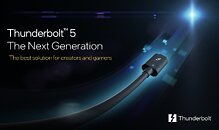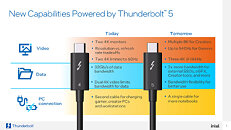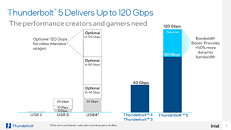- Joined
- Oct 9, 2007
- Messages
- 47,670 (7.43/day)
- Location
- Dublin, Ireland
| System Name | RBMK-1000 |
|---|---|
| Processor | AMD Ryzen 7 5700G |
| Motherboard | Gigabyte B550 AORUS Elite V2 |
| Cooling | DeepCool Gammax L240 V2 |
| Memory | 2x 16GB DDR4-3200 |
| Video Card(s) | Galax RTX 4070 Ti EX |
| Storage | Samsung 990 1TB |
| Display(s) | BenQ 1440p 60 Hz 27-inch |
| Case | Corsair Carbide 100R |
| Audio Device(s) | ASUS SupremeFX S1220A |
| Power Supply | Cooler Master MWE Gold 650W |
| Mouse | ASUS ROG Strix Impact |
| Keyboard | Gamdias Hermes E2 |
| Software | Windows 11 Pro |
Today, Intel announced Thunderbolt 5 - the next generation of Thunderbolt - and demonstrated a prototype laptop and dock. Thunderbolt 5 promises to deliver significant improvements in connectivity speed and bandwidth benefits for computer users.
"Thunderbolt 5 will provide industry-leading performance and capability for connecting computers to monitors, docks, storage and more. Intel is excited to continue our tradition of leadership for wired connectivity solutions. Thunderbolt is now the mainstream port for connectivity on mobile PCs, and delivering the next generation of performance with Thunderbolt 5 will provide even more capability for the most demanding users," said Jason Ziller, general manager of the Client Connectivity Division at Intel.



Thunderbolt 5 will deliver 80 gigabits per second (Gbps) of bi-directional bandwidth, and with Bandwidth Boost it will provide up to 120 Gbps for the best display experience. These improvements will provide up to three times more bandwidth than the best existing connectivity solution, providing outstanding display and data connections. Thunderbolt 5 will meet the high bandwidth needs of content creators and gamers. Built on industry standards - including USB4 V2 - Thunderbolt 5 will be broadly compatible with previous versions of Thunderbolt and USB.
Bandwidth needs of content creators, gamers and professionals are increasing significantly. These users want high-resolution displays and low-latency visuals while working with increasingly larger video and data files. Thunderbolt 5 has been designed to massively improve connectivity speed and bandwidth to ensure modern PC users can enjoy the highest-quality visuals and immersive experiences for years to come.
"Microsoft is excited to closely collaborate with Intel to bring the latest USB4 standard to Windows customers," said Ian LeGrow, corporate vice president of Core OS product management at Microsoft Corp. "Thunderbolt 5 is fully USB 80 Gbps standard compliant to support the next generation of high-performance displays, storage and connectivity."
Thunderbolt 5 builds upon Thunderbolt 4 in several ways, including:
The announcement of Thunderbolt 5 is another milestone in Intel's long history of leading the industry in input/output (I/O) innovation. Intel works closely with PC, accessory and cable partners to deliver the most advanced and complete wired connectivity solutions through dedicated enabling and testing programs.
All Thunderbolt products undergo stringent certification testing to ensure the best wired connection solution performance for the PC industry. Products that pass this testing use the Thunderbolt brand royalty-free. That's why Thunderbolt has become a globally recognized indicator of the best wired connectivity solutions for PCs and accessories.
Computers and accessories based on Intel's Thunderbolt 5 controller, code-named "Barlow Ridge," are expected to be available starting in 2024.
View at TechPowerUp Main Site
"Thunderbolt 5 will provide industry-leading performance and capability for connecting computers to monitors, docks, storage and more. Intel is excited to continue our tradition of leadership for wired connectivity solutions. Thunderbolt is now the mainstream port for connectivity on mobile PCs, and delivering the next generation of performance with Thunderbolt 5 will provide even more capability for the most demanding users," said Jason Ziller, general manager of the Client Connectivity Division at Intel.



Thunderbolt 5 will deliver 80 gigabits per second (Gbps) of bi-directional bandwidth, and with Bandwidth Boost it will provide up to 120 Gbps for the best display experience. These improvements will provide up to three times more bandwidth than the best existing connectivity solution, providing outstanding display and data connections. Thunderbolt 5 will meet the high bandwidth needs of content creators and gamers. Built on industry standards - including USB4 V2 - Thunderbolt 5 will be broadly compatible with previous versions of Thunderbolt and USB.
Bandwidth needs of content creators, gamers and professionals are increasing significantly. These users want high-resolution displays and low-latency visuals while working with increasingly larger video and data files. Thunderbolt 5 has been designed to massively improve connectivity speed and bandwidth to ensure modern PC users can enjoy the highest-quality visuals and immersive experiences for years to come.
"Microsoft is excited to closely collaborate with Intel to bring the latest USB4 standard to Windows customers," said Ian LeGrow, corporate vice president of Core OS product management at Microsoft Corp. "Thunderbolt 5 is fully USB 80 Gbps standard compliant to support the next generation of high-performance displays, storage and connectivity."
Thunderbolt 5 builds upon Thunderbolt 4 in several ways, including:
- Two times the total bi-directional bandwidth; Bandwidth Boost provides up to three times the throughput for video-intensive usage, up to 120 Gbps.
- Double the PCI Express data throughput for faster storage and external graphics.
- Built on industry standards including USB4 V2, DisplayPort 2.1 and PCI Express Gen 4; fully compatible with previous versions.
- Double the bandwidth of Thunderbolt Networking for high-speed PC-to-PC connections.
- Utilizes a new signaling technology, PAM-3, to deliver these significant increases in performance with today's printed circuit boards, connectors and passive cables up to 1 meter.
The announcement of Thunderbolt 5 is another milestone in Intel's long history of leading the industry in input/output (I/O) innovation. Intel works closely with PC, accessory and cable partners to deliver the most advanced and complete wired connectivity solutions through dedicated enabling and testing programs.
All Thunderbolt products undergo stringent certification testing to ensure the best wired connection solution performance for the PC industry. Products that pass this testing use the Thunderbolt brand royalty-free. That's why Thunderbolt has become a globally recognized indicator of the best wired connectivity solutions for PCs and accessories.
Computers and accessories based on Intel's Thunderbolt 5 controller, code-named "Barlow Ridge," are expected to be available starting in 2024.
View at TechPowerUp Main Site







